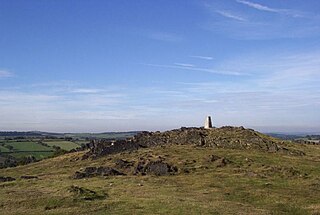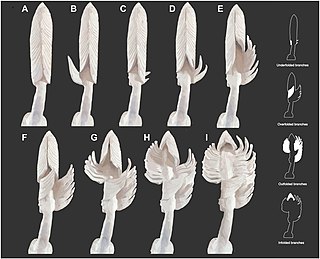
Cyclomedusa is a circular fossil of the Ediacaran biota; it has a circular bump in the middle and as many as five circular growth ridges around it. Many specimens are small, but specimens in excess of 20 cm are known. The concentric disks are not necessarily circular, especially when adjacent individuals interfere with each other's growth. Many radial segment lines — somewhat pineapple-like — extend across the outer disks. A few specimens show what might be a stem extending from the center in some direction or other.

Charnia is an extinct genus of frond-like lifeforms belonging to the Ediacaran biota with segmented, leaf-like ridges branching alternately to the right and left from a zig-zag medial suture. The genus Charnia was named after Charnwood Forest in Leicestershire, England, where the first fossilised specimen was found; the species name after Roger Mason, a schoolboy who found it. Charnia is significant because it was the first Precambrian fossil to be recognized as such.

Charnwood Forest is a hilly tract in north-western Leicestershire, England, bounded by Leicester, Loughborough and Coalville. The area is undulating, rocky and picturesque, with barren areas. It also has some extensive tracts of woodland, and significant Precambrian geology. Its elevation is generally 600 feet (180 m)and upwards, the area exceeding this height being about 6,100 acres (25 km2). The highest point, Bardon Hill, is 912 feet (278 m). On its western flank lies an abandoned coalfield, with Coalville and other former mining villages, now being regenerated and replanted as part of the National Forest. The M1 motorway, between junctions 22 and 23, cuts through Charnwood Forest.

Charniodiscus is an Ediacaran fossil that in life was probably a stationary filter feeder that lived anchored to a sandy sea bed. The organism had a holdfast, stalk and frond. The holdfast was bulbous shaped, and the stalk was flexible. The frond was segmented and had a pointed tip. There were two growth forms: one with a short stem and a wide frond, and another with a long stalk, elevating a smaller frond about 50 centimetres (20 in) above the holdfast. While the organism superficially resembles the sea pens (cnidaria), it is probably not a crown-group animal.

Aspidella is an Ediacaran disk-shaped fossil of uncertain affinity. It is known from the single species A. terranovica.

Thectardis avalonensis is a triangular-shaped member of the Ediacaran biota, dating from 574 to 565 million years ago. The organism took the form of an elongated cone with a central depression, and its apex was anchored to the substrate.

The Ediacaranbiota is a taxonomic period classification that consists of all life forms that were present on Earth during the Ediacaran Period. These were enigmatic tubular and frond-shaped, mostly sessile, organisms. Trace fossils of these organisms have been found worldwide, and represent the earliest known complex multicellular organisms. The term "Ediacara biota" has received criticism from some scientists due to its alleged inconsistency, arbitrary exclusion of certain fossils, and inability to be precisely defined.

Vendiamorpha is a class of extinct animals within the Ediacaran phylum Proarticulata.

Fractofusus misrai is an Ediacaran fossil discovered in 1967 by S.B. Misra at Mistaken Point, Newfoundland and Labrador, Canada, which has since become the Mistaken Point Ecological Reserve. It was named after Professor Misra in 2007. It represents a frondose rangeomorph, and its overall body plan shows glide reflection symmetry, which is typical of the clade. It is one of two described species in the genus Fractofusus, the other being Fractofusus andersoni.

Mistaken Point Ecological Reserve is a wilderness area and a UNESCO World Heritage Site located at the southeastern tip of Newfoundland's Avalon Peninsula in the Canadian province of Newfoundland and Labrador. The reserve is home to the namesake Mistaken Point Formation, which contains one of the most diverse and well-preserved collections of Precambrian fossils in the world. Ediacaran fossils discovered at the site constitute the oldest known remnants of multicellular life on Earth.

The "ivesheadiomorphs" are a group of fossilised structures known from Ediacaran localities in England and Newfoundland. They are considered to be taphomorphs, representing the poorly preserved biological remains of various contemporary taxa such as Charnia, Charniodiscus, Bradgatia, Primocandelabrum, Pectinifrons and others, that were effaced by partial decay by micro-organisms following death on the seafloor before burial by sediment.

Primocandelabrum is a genus of rangeomorph known from the Avalon-type Ediacaran biota. It makes up the brunt of some bedding plane assemblages. Primocandelabrum was described by Hofmann, O'Brien, and King in 2008.

The Avalon explosion, named from the Precambrian faunal trace fossils discovered on the Avalon Peninsula in Newfoundland, eastern Canada, is a proposed evolutionary radiation of prehistoric animals about 575 million years ago in the Ediacaran period, with the Avalon explosion being one of three eras grouped in this time period. This evolutionary event is believed to have occurred some 33 million years earlier than the Cambrian explosion, which had been long thought to be when complex life started on Earth.

The Mistaken Point Formation is a geologic formation in Newfoundland and Labrador. It is recognized as a Lagerstätte preserving fossils dating back to the Ediacaran period. It contains a stratum dated to 565 ± 3 million years ago.

Parviscopa is a genus of frondose forms characterized in 2008 based on specimens from Newfoundland, Canada. Parviscopa is a member of the Ediacaran biota, and is more specifically part of the Avalon type assemblage, which is from the older part of the Ediacaran and is characterized by deep water deposits.

Frondophyllas is an extinct, monotypic animal genus in the clade Rangeomorpha. It was found at the Mistaken Point on the Avalon Peninsula in Newfoundland, Canada in 2008 by Bamforth and Anderson. The single species is Frondophyllas grandis and as of 2021 only two specimens have been discovered. Both specimens are incomplete, but one extends to one meter long, making it one of the largest Ediacaran macrofossils. The species name: grandis, comes from its size, and the genus name: Frondophyllas means "frond with leaves". The organism has a base structure with numerous fronds attached to it. It is the only Ediacaran organism to have distinct leaflets. Evidence suggests that F. grandis may have been tethered to the seafloor and used these leaflets to "filter feed", or live off nutrients provided by a current. One of the reasons fossils of this species are so rare is because it was a soft-bodied organism. It is believed that F. grandis was preserved because it was caught beneath quickly solidifying volcanic ash. Many of the Mistaken Point fossils were preserved this way.
Hadrynichorde is a frondose organism from the Ediacaran period discovered in Newfoundland, Canada. It is a sessile, benthic marine organism. resembling modern sea whips.
Hylaecullulus fordi, also described as dumbbells, is an extinct species of Ediacaran petalonamid whose fossils were found in the Charnwood Forest of Leicestershire, England. It serves as an important rangeomorph because of its multifoliate anatomy. Its overall body plan is similar to that of a goblet, from which its name, Hylaecullulus, is derived from.
Tina Negus is a British zoologist, painter and poet who is credited as the original discoverer of Charnia, the first ever known Precambrian fossil. A fossil enthusiast since childhood, she found the first specimen of frond-like fossil at Charnwood Forest in Leicestershire during a summer vacation in 1956. She studied zoology, botany and geography at the University of Reading. She took up zoology for her postgraduate degree and her dissertation research on mussel diversity and abundance, published in the Journal of Animal Ecology in 1966, became a fundamental information on the degree of pollution in the River Thames. In recognition of her pioneering work, the University of Reading commissioned the Tina Negus Prize to graduate students of biology since 2019.
















